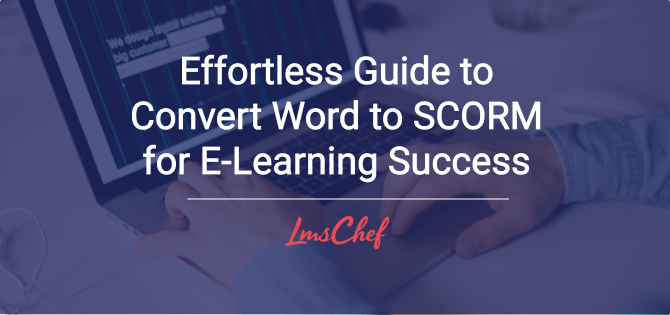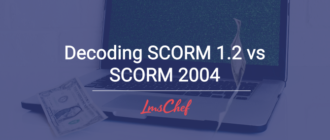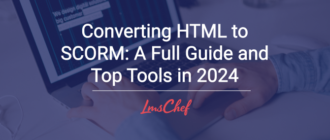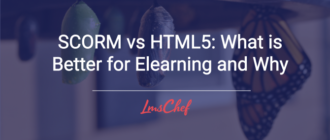Looking to convert Word to SCORM? Learn the direct path to transforming your Word documents into SCORM-compatible e-learning content. Our guide simplifies the conversion process, explains formatting for compatibility, and introduces you to the best authoring tools for effective SCORM packages. Get ready to make your content widely accessible and trackable across multiple learning management systems.
Key Takeaways
- SCORM is essential for e-learning as it allows interoperable and compatible content delivery across various platforms and lets developers track learner progress.
- Successfully converting Word documents to SCORM packages requires careful formatting, using the right SCORM authoring tool, and meticulous testing for compatibility with LMSs.
- Choosing the appropriate SCORM converter with robust features and ensuring mobile optimization and compliance during content updates are crucial for long-term e-learning success.
Understanding SCORM and Its Importance in E-Learning
SCORM, short for Shareable Content Object Reference Model, is a technical standard that has transformed the field of online education. This complex acronym allows for the creation of engaging digital learning experiences and enables seamless integration across different platforms. By complying with SCORM requirements, your carefully crafted course can be easily deployed on any compatible learning management system, expanding its reach and effectiveness.
But why convert Word documents into SCORM? One major advantage of using SCORM is its compatibility and interoperability features. Converting a Word document into a SCORM package bundles all educational content into one portable unit that can be effortlessly delivered through multiple learning management systems. This conversion also offers valuable progress tracking capabilities to e-learning developers in assessing the impactivity of their course materials.
The Essentials of Converting Word Documents to SCORM Packages
Converting Word documents into SCORM packages may seem overwhelming, but with the right approach it can be easily accomplished. A key factor in this process is understanding how formatting impacts file size, uploading and downloading speed, and compatibility with SCORM-compliant learning management systems. Ensuring that your document aligns with SCORM standards is crucial for a smooth conversion.
Despite its importance, there are various challenges that may arise during the conversion of word to scorm package. These include video or scorm errors caused by network or server issues as well as problems related to files uploaded by instructors. Display issues such as objects being too small or large can also occur if not addressed properly. To overcome these obstacles effectively, following best practices such as choosing an appropriate version of SCORM and utilizing authoring tools will prove beneficial along with optimizing file size and format, conducting regular tests on the package’s functionality, and regularly updating content.
Step-by-Step Conversion: Word to SCORM Made Simple ->

After understanding the fundamentals, we can now move on to the detailed steps of transforming a Word document into a SCORM course. This process involves three main stages – preparing your Word file, selecting an appropriate authoring tool, and finally packaging and publishing your SCORM content.
Ready to begin? Let’s get started!
Preparing Your Word File for Conversion
Preparing your Word document for conversion into a SCORM course is essential to ensure a smooth process. This involves considering factors like the file size, fonts used, and maintaining its intended visual appearance.
The organization of text layout in your Word document also plays an important role in the successful conversion of a scorm course. The ‘title’ field and links can be modified in the immanifest.xml file to align with the specific content of your course. Using compliant authoring tools can simplify this process by providing testing functionalities. It’s crucial to remember that having a well-prepared Word document serves as the foundation for creating an effective SCORM course.
Choosing the Right Authoring Tool
After finalizing your proposal, you can finish it. Word file, the next step is to select an appropriate authoring tool for converting it into a SCORM course. The choice of this tool is crucial in successfully transforming your document. Deciding on the right one can be challenging.
When choosing an authoring tool, there are several important factors to consider such as:
- Your familiarity and experience with using the specific tool.
- Its essential features like support for responsive design and online assessment tools.
- Availability of sufficient resources and assistance for utilizing the chosen authoring tool effectively in creating a scorm-compliant course.
Packaging and Publishing as a SCORM File
Once you have your own account you can start a new one. Word file ready and an appropriate authoring tool at hand, it’s time to package and publish your SCORM file. A helpful option for this task is using a program like iSpring Suite that allows for direct conversion of Word files into SCORM courses.
When creating packages for your scorm file, there are several important steps to follow.
- Specify the desired version of SCORM (e.g., 1.2 or 2004).
- Export the scorm as a zip folder containing all necessary files.
- Upload the zipped package onto the Learning Management System (LMS).
- Test its compatibility and functionality before finalizing publication on LMS platform(s).
Selecting a SCORM Converter: Features to Look For
After finishing the packaging and publishing process for your SCORM file, there is still an important step left – choosing a suitable SCORM converter. This tool plays a crucial role in ensuring that your e-learning content remains accessible and effective as technology advances.
When selecting a SCORM converter that supports this format, it’s essential to consider its tracking capabilities, options for individual training assessment, and comprehensive course features presented in an easy-to-use interface. Factors such as security and accessibility should be taken into account when deciding between cloud-based or desktop-based converters.
Apart from just the features offered by the converter software itself. Its compatibility with different platforms and learning management systems (LMSs) also greatly affects its performance. Selecting a compatible SCORM-supported converter is imperative if you want seamless operation of your e-learning courses across various devices.
Top Tools for Seamless Word to SCORM Conversion

Choosing the right tool from a plethora of options can seem overwhelming. But fear not, we have compiled a list of top tools for converting Word documents to SCORM seamlessly. These include iSpring Suite, Adobe Captivate and Articulate Storyline 360 – all tried and tested for their efficacy in this task. It is important to select the most suitable one based on your requirements and project needs as each offers its own unique features and advantages.
Some highly effective tools used for converting word documents into SCORM format are Adobe Captivate, Articulate Storyline 360 and iSpring Suite. Each tool has been carefully evaluated by experts who vouch that they deliver desired results with ease.This enables you too, to pick an option which will fulfill your individual goals without any difficulty.
Integrating Interactive Elements in Your SCORM Course ->
Transforming a Word document into a SCORM package opens up opportunities for enriching your elearning course with engaging features. These may include incorporating various interactive elements, such as multimedia components like images, audio and video clips, along with interactive assessments and quizzes that can effectively enhance learner involvement and improve retention of information.
Enhancing Engagement with Multimedia
Multimedia elements are highly beneficial in enhancing the learning process due to their ability to increase engagement and facilitate understanding. A variety of multimedia components, such as videos, images, audio files, interactive quizzes, animations and simulations, can be incorporated into SCORM packages.
Utilizing these multimedia elements results in increased learner engagement and improved retention of knowledge. When inserting videos or interactive images into PowerPoint presentations for use in SCORM packages, it is recommended that MP4 format is used for video files while tools like Genially allow creation and export of interactive images compatible with SCORM package requirements.
When integrating audio content, it’s important to pay attention to the format chosen and minimize any repetitive text-to-speech patterns.While incorporating audio, a useful approach would be using it for explaining complex concepts rather than simply repeating written text. Overall, integrating various multimedia features effectively enhances a scorm package presentation resulting in an engaging learning experience for learners.
Crafting Interactive Quizzes and Assessments
In SCORM courses, incorporating multimedia elements and interactive quizzes can significantly enhance learner engagement. These tools offer instant feedback, promote active learning, and allow for self-assessment to create a more engaging learning experience.
There are various options available when it comes to creating these types of assessments such as Adobe Captivate, Articulate Storyline, iSpring Suite among others. Whether you require drag-and-drop quizzes or multiple choice questions with hotspots, these software programs have all the necessary features.
To make SCORM courses more dynamic and immersive for learners, there are an array of tools that can be utilized including but not limited to those mentioned above. With their wide range of quiz formats like dragging items into specific areas on screen or answering through visual cues, keep users stimulated throughout the course material, promoting better knowledge retention while enabling immediate testing post session completion.
Testing and Troubleshooting Your SCORM Package
Once you have completed all necessary steps, it is important to thoroughly test and troubleshoot your SCORM package. This includes intentionally causing errors in the module, checking for completion and success statuses, and reviewing the content to ensure smooth operation.
There are multiple tools available for testing a SCORM package such as using the sandbox feature on SCORM Cloud or utilizing programs like SCORM Debugger. Utilizing these resources can help identify any potential issues that may arise so that they can be addressed effectively, ensuring optimal functionality of your e-learning course.
While there may be challenges along the way when working with scorm packages such as compatibility problems between learning platform advancements and LMS systems for online courses or selecting which version of scorm to use. By staying diligent these obstacles can be overcome. It is also crucial to consider optimizing content specifically designed for mobile platforms as well testing out various devices during this process.
Optimizing SCORM Courses for Mobile Learning

As digital technology continues to advance, more and more learners are turning to mobile devices for their learning needs. Thus, it is imperative that SCORM courses be adapted for mobile learning in order to ensure maximum effectiveness. This involves careful selection of the appropriate version of SCORM standards, adjusting content specifically for use on mobile devices, and conducting comprehensive testing across a variety of different models.
In order to guarantee accessibility on various screen sizes when viewed from a smartphone or tablet device, it is essential that courses be developed using an authoring tool compatible with SCORM guidelines regarding responsive design. Utilizing tools such as EdApp along with other available authoring options which support responsiveness will allow optimal optimization of your scorm course material intended for consumption via handheld electronic means.
Maintaining SCORM Compliance Throughout Updates
To ensure that your e-learning content remains compatible and efficient, it is crucial to stay up-to-date with the constant advancements in technology. This is where maintaining SCORM compliance becomes essential during updates. Being SCORM compliant means adhering to the technical standards set by SCORM, which guarantees compatibility with systems that are also conformant.
Careful attention must be paid while updating to maintain SCORM compliance. This involves checking for the correct version of SCORM, using a proper authoring tool designed specifically for creating scorm content, testing all aspects of the scorm material after changes have been made, documenting those modifications and effectively communicating them with learners who will use this updated e learning courseware.While challenges may arise during this process, it can be easily overcome by staying informed about any refinements being made within scorm’s technical requirements and utilizing an LMS checklist before choosing one.
Summary
The conversion of Word documents into SCORM courses is a crucial step in developing effective and interactive eLearning content. Understanding the significance of using SCORM, following proper conversion techniques, utilizing authoring tools effectively, and conducting thorough testing and troubleshooting are all important factors in creating engaging e-learning material that meets SCORM standards. Are you prepared to transform your Word documents into dynamic and compliant scorm courses for impactful online learning experiences?
Frequently Asked Questions
How do I convert to SCORM format?
One way to convert a PowerPoint (PPT) presentation into the SCORM format is by using iSpring. To do so, simply open the PPT in iSpring and click on Publish. From there, choose the option for converting to SCORM.
This process will effectively transform your presentation into a scorm file that can be used with compatible learning management systems (LMS).
Can I convert PDF to SCORM?
Converting a PDF into SCORM files can be accomplished through an authoring tool by incorporating the content from your PDF and exporting it as a SCORM file using the ‘Publish’ function. This allows you to easily create multiple scorm files from various types of documents such as PDFs, ensuring compatibility with different e-learning platforms.
Does articulate create SCORM files?
The creation of SCORM files is made possible in Articulate Storyline 360 through a user-friendly interface designed specifically for publishing. The process allows you to efficiently generate the necessary files for seamless integration into any SCORM compliant system.
What is SCORM and why is it important in e-learning?
In the realm of e-learning, SCORM plays a crucial role by guaranteeing consistency in content across different learning management systems. This allows for effortless sharing and monitoring of e-learning resources.
Ultimately, incorporating SCORM into e-learning initiatives improves their efficiency and effectiveness significantly. It streamlines processes such as tracking progress and generating reports, thereby enhancing the overall quality of online education.
How can I optimize my SCORM course for mobile learning?
When creating a SCORM course for mobile learning, it is important to select the appropriate version of SCORM and modify content specifically for use on mobile devices. It is crucial to thoroughly test the course across different types of mobile devices in order to ensure compatibility and provide a smooth learning experience for users.
To achieve optimal results with your scorm-based training designed for learners using their smartphones or tablets, make sure you carefully consider which scorm version will be most effective.







